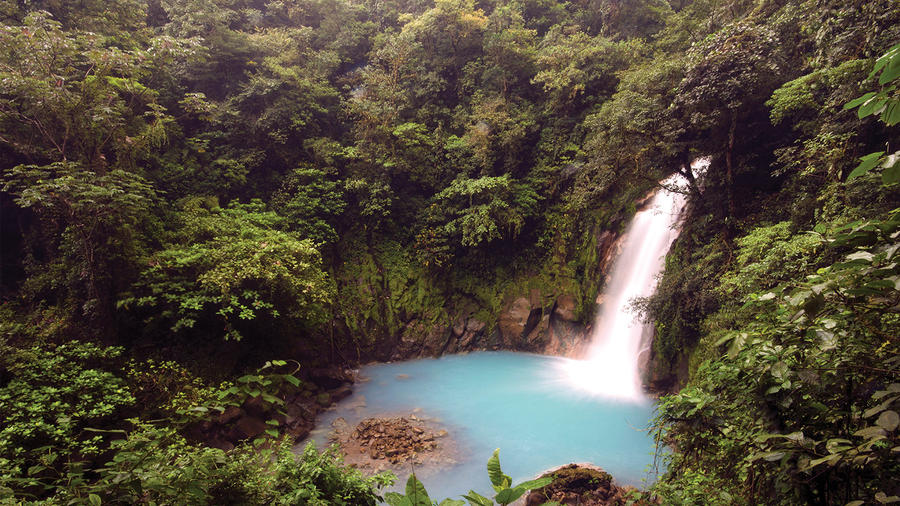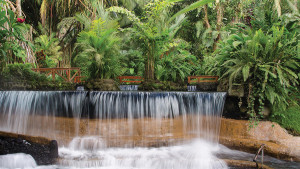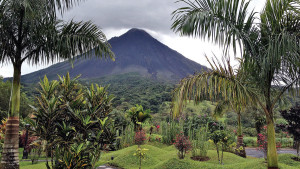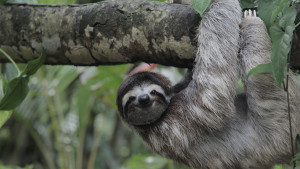
Why you should visit Costa Rica during the green ‘rainy’ season
Travel: Non-Stop
By Stephanie Citron for The Baltimore Sun
After a morning spent dodging crocodiles on a safari down the Corobici River, you can catch an afternoon nap on the beach, perhaps beneath a snoozing sloth hanging from a tree. Your slumber is accompanied alternatively by crashing ocean waves and screeching monkeys.
Staying a week in Costa Rica provides opportunities for closeup encounters with exotic wildlife, canopy tours across forests and treks around volcanoes, all in a spectacular setting encompassing one of the world’s most diverse ecosystems.
How far do you have to travel to find this paradise? About five hours via a nonstop flight from Baltimore.
Tiny Costa Rica, smaller than the state of West Virginia, is abundant in spectacular natural landscapes and exotic biodiversity. An increasingly popular destination for tourists, the country offers more than 900 miles of picturesque coastline with lush rain forests, mountain lakes and jungles thriving with red-eye tree frogs, macaws, anteaters, jaguars and more.
While Costa Ricans, known locally as “ticos,” might not be materially prosperous, they live rich lives. The country’s signature catch phrase, “pura vida” — pure life — says it all. In 1948, the country disassembled its military and instead poured the money into education, health care and environmental protection. Today, it boasts a 93 percent literacy rate with a universal health care system that is said to be the best in Latin America. Costa Rica now ranks among the top nations in the world for life expectancy.
The country borders the Caribbean Sea and the Pacific Ocean. While the bodies of water are just about 160 miles apart, their cultural vibe and geographic hallmarks are as dissimilar as the east and west coasts of the United States.
High season in Costa Rica is December through April, when tourists are assured of perpetual sunshine. But true adventurers who opt to visit during the “green season” are rewarded with the most magnificent flora and fauna, and smaller crowds. Lodging rates drop substantially, from 30 percent to 50 percent off high-season rates.
Surprising to many, May through early September is not a washout. Visitors enjoy luminous mornings and refreshing afternoon rain lasting only minutes, followed by clear skies before dinnertime. The weather yields eye-popping shades of green as well as plentiful views of the wildlife that come out in droves, invigorated by newly replenished watering holes.
The daily rains also create peak surfing conditions, rushing rafting rapids and waterfalls. Beyond those adventures, there is plenty to see and do. Here are some of the highlights.
San Jose
Almost immediately upon landing at Juan Santamaria International Airport in San Jose, the majority of travelers hightail out to the beaches on the Pacific Coast or up north to the highlands for volcano tours. While not a picturesque city, San Jose, Costa Rica’s capital, is definitely worth a look.
Amid the profusion of concrete structures, downtown has museums, preserved Spanish colonial architecture and bustling markets selling local provisions and crafts.
Begin at the Plaza de la Cultura and tour the neoclassical National Theater. Next, check out the impressive pre-Columbian gold collection at the Central Bank Museum. Nearby, the Jade Museum is reputed to possess the largest collection of jade in the Americas. The National Museum of Costa Rica has an enchanting butterfly garden and a collection of historical and archeological artifacts dating to pre-Columbian times. For lunch, Central Market is a great spot to sample local fare like casado, a platter including a tortilla, meat, rice, black beans, plantains and salad.
Arenal volcano
Four hours north of San Jose, Arenal has been Costa Rica’s most active volcano for more than 40 years. While there hasn’t been a significant eruption since 2010, nearly a half-century of eruptions has left behind a remarkable geological treasure: natural trails formed by lava tubes amid a forest filled with wildlife, including hundreds of species of birds. The surrounding region offers lake craters, geothermal hot springs, whitewater rafting, horseback riding, and canopy and hanging bridge excursions.
Pacific coast
Guanacaste: The Costa Rica most American tourists envision — and flock to — is found in Guanacaste, in the country’s northern sector along the Pacific Ocean, with its forest-fringed beaches fronting a turquoise sea. Beyond the sand is a wonderland of jungle, dramatic cliffs, wildlife and geological treasures waiting to be explored. Accordingly, this area offers the country’s largest selection of accommodations, restaurants, and organized tours and activities. Visitors embark on rain forest treks across hanging bridges and soar across zip lines over the tallest trees in a high-altitude cloud forest. The nearby Cloud Forest Biological Reserve, home to hundreds of species of mammals, amphibians, reptiles and birds, offers thousands of acres with trails.
Nicoya Peninsula: Just south is the Nicoya Peninsula where the vibe is decidedly more Zen. in a designated Blue Zone, a region where populations have been discovered to live remarkably longer, healthier lives, natives and resident surf bums quench their thirst with calcium- and magnesium-rich water and eat very little processed food. Until recently, the profusion of unpaved roads without bridges deterred the masses, thus protecting its natural beauty. But explorers are becoming increasingly aware of its raw landscape, unencumbered wildlife and sleepy villages with bohemian cafes.
Manuel Antonio State Park: The central Pacific region is home to Manuel Antonio State Park, one of the Costa Rica’s top eco-tourism destinations. Home to hundreds of species of wildlife, this rain forest microclimate is the perfect habitat for the likes of scarlet macaws, brown boobies, white-faced monkeys and toed anteaters. The central coast is also home to Playa de Jaco, popular because it is the closest beach to San Jose, therefore crowded and more commercial. For scenic solitude, check out Playa Baru, nestled between the Pacific Ocean and the spectacular 800-acre Hacienda Baru Wildlife Refuge, or take a boat trip 12 miles across the crystal blue water to the biological reserve on the pre-Columbian-era Cano Island. There’s also the Rainmaker Aerial Walkway, the first to be built in Central America, peaking to a staggering 20 stories above the jungle floor between its tree-to-tree platforms.
Zona Sur. For the truly rugged adventurer, Osa Peninsula and Golfo Dulce in the southern region, known as Zona Sur, on Costa Rica’s southwestern tip, is the country’s most primitive and undeveloped terrain. Just getting here is difficult; many of the roads are little more than rutted, unpaved byways, with unpredictable river crossings and long-forgotten, overgrown paths. A bastion of tropical wilderness bordered by a pristine, craggy coastline, the region is largely made up of protected reserves and parks, including Corcovado National Park, Costa Rica’s largest park and home to nearly 10 percent of all mammals found in the Americas. Given just a smattering of overnight accommodations, nature lodges are the best choice since they can organize guides for jungle treks, climbing expeditions, kayak tours and snorkeling trips.
While the majority of Costa Rica’s residents are Spanish-speaking Latin Americans, many of the people along its Caribbean coastline descend from Afro-Caribbean origins and indigenous tribes. In addition to Spanish, the main language here is Creole patois.
Possessing as many natural wonders as the Pacific side, this coast tends to be less expensive. Known as the “wetter” side — September and October are the driest months here — residents say the daily rain produces a healthy, lush, and vibrant flora. As a result, the region is void of large-scale resort chains and harbors less-touristy fanfare. Instead, visitors enjoy snorkeling in the blue-green ocean, deep-sea fishing and local village life. Even the food differs here. Rather than traditional rice and beans, Creole influence dominates local fare like rondon, a spicy gumbo-style dish with vegetables and fish simmered in coconut milk and spices.
Ranked among the top surfing destinations in the world, the southern town of Puerto Viejo de Talamanca attracts artists, surfers, and New Agers with its laid-back seaside town and reggae and calypso nightspots.
The middle coast is largely rustic, with small towns and villages, and desolate beaches. Cahuita is a worthwhile stop to check out its black sand beach and Sloth Sanctuary. The town is especially noted for its authentic Afro-Caribbean cuisine and reasonably priced lodging.
Limon, along the northern Caribbean sector, is a lively port city, renowned for its nesting turtles. Its most popular destination, Tortuguero National Park , protects a range of wildlife including caimans, jaguars, manatees and the nesting sites for the leatherback, loggerhead, hawksbill and green sea turtles. Like much of the rest of the region, the sanctuary doesn’t offer organized activities beyond simply viewing these magnificent creatures in their authentic habitats. Nearby, don’t miss the Jaguar Rescue Center, which also works to heal birds, monkeys and reptiles.
If you go
Getting there
Southwest Airlines flies nonstop from BWI-Marshall to San Jose, Costa Rica’s capital city. From there, it’s about a 2½ -hour drive to the Pacific Coast and 4½ hours to the Caribbean side. In November, Southwest will begin service from Baltimore to Liberia, Costa Rica, landing travelers within a short drive of Guanacaste on the Pacific Coast. Fares start around $170 one-way.
Getting around
To really explore the country, renting a car is essential, however driving is risky here. Many roads are left untended, with potholes, mud and debris; some are washed out. Signs are often nonexistent, so a GPS is necessary. Be certain to read the rental policy for tariffs, fees and liability.
Lodging
In the popular tourist regions, options are plentiful, including luxurious resort hotels, condominiums, vacation homes, B&B’s and budget accommodations. In more remote areas, choices are limited to eco-lodges, smaller family-run establishments and guesthouses. Here are a few recommendations:
Pacific Coast
Arenas Del Mar. Breathtaking, sustainable beachfront hotel near Quepos on the edge of the rainforest with two swimming pools, spa, and fine dining serving local fare. Rates from $270 per night. (arenasdelmar.com)
Lapa Rios Eco Lodge. Set on 1,000 acres of rain forest overlooking the Pacific Ocean in the Osa Peninsula, this lodge offers beach bungalows with thatched roofs and glassed-in showers with jungle views. Rates from $595 per night. (laparios.com)
Volcano region
Nayara Hotel, Spa and Gardens. At the base of the Arenal volcano, guests stay in huge private casitas with private backyard gardens, outdoor showers and terraces with Jacuzzis facing the volcano. From $257 per night. (arenalnayara.com)
San Jose
Hotel Grande Oro. In the heart of the capital city, the personalized service at this restored Victorian mansion makes you feel like you are visiting fancy relatives. Rooms have antique Spanish furnishings. From $145 per night. (hotelgranodeoro.com)
Caribbean Coast
Le Cameleon Boutique Hotel. Nestled between the golden sand of Cochols Beach and the rain forest in Puerto Viejo de Talamanca, this very Zen hotel has soothingly white guest rooms, a spa and private beach club. From $144 per night. (lecameleonhotel.com)
Laguna Lodge. Perched on a peninsula between a jungle canal and the Caribbean, guests arrive at the Tortuguero lodge by boat. Accommodations are upscale but rustic, with no televisions or Wi-Fi, encouraging guests to connect with nature. Everything here is included: transportation from San Jose, activities including river, jungle and turtle nesting tours, and meals made with local provisions. From $235 per night. (lagunatortuguero.com)
Dining
Costa Rica has a wide array of options, from fine dining to roadside eateries. Try to forgo the fancy restaurants for a meal or two and hit a soda, a BYOB mom-and-pop cafe with just a few tables serving up homecooked Costa Rican comfort fare.
Cafe Bohemia Boutique. Dine under the stars in the home of the chef, along with her family and friends in Puerto Quepos. Every dish and cocktail is prepared to order, with fresh, local, and often homegrown, ingredients.
Drakes Kitchen. Tonight’s catch of the day came off the boat that afternoon at this eatery on the beach at Drake Bay. The produce for smoothies was grown on the chef’s farm.
El Tigre Vestido Restaurant and Bar Buho. Imaginative takes on traditional Costa Rican dishes, prepared with homegrown herbs and produce. Heredia. (eltigrevestido.com/en)
Jungle Love Cafe. Lively family-operated Caribbean-fare eatery in Puerto Viejo de Talamanca. The owners grow their own vegetables and offer vegan options, along with dishes like mango chicken and curried vegetables. (junglelovecafe.com)
Information
Time zone. Costa Rica is on Central Standard time and does not adhere to daylight saving time.
For more information, go to visitcostarica.com.
Copyright © 2015, The Baltimore Sun
Copyright @ 2015, The Baltimore Sun




